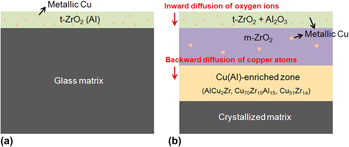Crossref Citations
This article has been cited by the following publications. This list is generated based on data provided by
Crossref.
Lim, Ka-Ram
Kim, Won-Tae
and
Kim, Do-Hyang
2012.
Characterization of the Oxide Layer Formed on the Cu-Zr Based Metallic Glass during Continuous Heating.
Applied Microscopy,
Vol. 42,
Issue. 3,
p.
174.
Chang, Hye Jung
Park, Eun Soo
and
Kim, Do Hyang
2013.
Nano-scale Shell in Phase Separating Gd-Ti-Al-Co Metallic Glass.
Applied Microscopy,
Vol. 43,
Issue. 2,
p.
98.
Lim, Ka Ram
Park, Jin Man
Jee, Sang Soo
Kim, Se Yun
Kim, Suk Jun
Lee, Eun-Sung
Kim, Won Tae
Gebert, Annett
Eckert, Jürgen
and
Kim, Do Hyang
2013.
Effect of thermal stability of the amorphous substrate on the amorphous oxide growth on Zr–Al–(Cu,Ni) metallic glass surfaces.
Corrosion Science,
Vol. 73,
Issue. ,
p.
1.
Kim, Kang Cheol
Lim, Ka Ram
Lee, Eun Sung
Kim, Won Tae
Gebert, Annett
Eckert, Jürgen
and
Kim, Do Hyang
2013.
Thermal stability of amorphous oxide in Al87Ni3Y10 metallic glass.
Corrosion Science,
Vol. 77,
Issue. ,
p.
1.
Lim, Ka Ram
Park, Jin Man
Kim, Suk Jun
Lee, Eun-Sung
Kim, Won Tae
Gebert, Annett
Eckert, Jürgen
and
Kim, Do Hyang
2013.
Enhancement of oxidation resistance of the supercooled liquid in Cu–Zr-based metallic glass by forming an amorphous oxide layer with high thermal stability.
Corrosion Science,
Vol. 66,
Issue. ,
p.
1.
Kim, Kang Cheol
Kim, Won Tae
and
Kim, Do Hyang
2013.
Formation of Amorphous Oxide Layer on the Crystalline Al-Ni-Y Alloy.
Applied Microscopy,
Vol. 43,
Issue. 4,
p.
173.
Lim, K. R.
Park, J. M.
Park, S. H.
Na, M. Y.
Kim, K. C.
Kim, W. T.
and
Kim, D. H.
2014.
Oxidation induced amorphous stabilization of the subsurface region in Zr-Cu metallic glass.
Applied Physics Letters,
Vol. 104,
Issue. 3,
p.
031604.
Jang, B. T.
Kim, S. S.
and
Yi, S.
2014.
Wear behaviors of a Fe-based amorphous alloy in ambient atmosphere and in distilled water.
Metals and Materials International,
Vol. 20,
Issue. 1,
p.
55.
Hennayaka, H.M.M.N.
Lee, Ho Seong
and
Yi, Seonghoon
2015.
Surface oxidation of the Fe based amorphous ribbon annealed at temperatures below the glass transition temperature.
Journal of Alloys and Compounds,
Vol. 618,
Issue. ,
p.
269.
Park, Sung Hyun
Lim, Ka Ram
Na, Min Young
Kim, Kang Cheol
Kim, Won Tae
and
Kim, Do Hyang
2015.
High thermal stability of the amorphous oxide in Ti44.5Cu44.5Zr7Be4 metallic glass.
AIP Advances,
Vol. 5,
Issue. 11,
Park, Sung Hyun
Lim, Ka Ram
Na, Min Young
Kim, Kang Cheol
Kim, Won Tae
and
Kim, Do Hyang
2015.
Oxidation behavior of Ti–Cu binary metallic glass.
Corrosion Science,
Vol. 99,
Issue. ,
p.
304.
Ma, C.F.
Wang, F.
Huang, P.
Lu, T.J.
and
Xu, K.W.
2015.
Hillock growth in CuZr metallic glass.
Thin Solid Films,
Vol. 589,
Issue. ,
p.
681.
Lim, Ka Ram
Cho, Tae Hee
Park, Sung Hyun
Na, Min Young
Kim, Kang Cheol
Na, Young Sang
Kim, Won Tae
and
Kim, Do Hyang
2016.
A novel approach to exploring glassy alloys with high oxidation resistance in the supercooled liquid region.
Corrosion Science,
Vol. 111,
Issue. ,
p.
846.
Park, Sung Hyun
Lim, Ka Ram
Na, Min Young
Kim, Kang Cheol
Kim, Won Tae
and
Kim, Do Hyang
2016.
Effect of minor addition of Zr on the oxidation behavior of Ti-Cu metallic glasses.
Metals and Materials International,
Vol. 22,
Issue. 2,
p.
229.
Shi, J.A.
Cao, C.R.
Zhang, Q.H.
Sun, Y.T.
Wang, C.
Wang, W.H.
Bai, H.Y.
and
Gu, L.
2017.
In situ atomic level observations of Al 2 O 3 forming on surface of metallic glasses.
Scripta Materialia,
Vol. 136,
Issue. ,
p.
68.
Liu, Binbin
Han, Chaoyu
and
Ye, Feng
2017.
Adjustment of temperature coefficient of electrical resistivity in Cu66Zr34 metallic glass through surface oxidation induced phase decomposition.
Corrosion Science,
Vol. 125,
Issue. ,
p.
166.
Xu, Yifei
Liu, Xinyu
Gu, Lin
Wang, Jiangyong
Schützendübe, Peter
Huang, Yuan
Liu, Yongchang
and
Wang, Zumin
2018.
Natural oxidation of amorphous Cu Zr1- alloys.
Applied Surface Science,
Vol. 457,
Issue. ,
p.
396.
Xu, Zhiqiang
Xu, Yifei
Zhang, An
Wang, Jiangyong
and
Wang, Zumin
2018.
Oxidation of amorphous alloys.
Journal of Materials Science & Technology,
Vol. 34,
Issue. 11,
p.
1977.
Louzguine-Luzgin
and
Jiang
2019.
On Long-Term Stability of Metallic Glasses.
Metals,
Vol. 9,
Issue. 10,
p.
1076.
Haratian, Saber
Grumsen, Flemming B.
Villa, Matteo
Christiansen, Thomas L.
and
Somers, Marcel A.J.
2019.
Surface hardening by gaseous oxidizing of (Zr55Cu30Al10Ni5)98Er2 bulk-metallic glass.
Journal of Alloys and Compounds,
Vol. 800,
Issue. ,
p.
456.





